Lecture 11e How a Boltzmann Machine models data
Modeling binary data
(이진 데이터 모델링)
• Given a training set of binary vectors, fit a model that will assign a probability to every possible binary vector.
- – This is useful for deciding if other binary vectors come from the same distribution (e.g. documents represented by binary features that represents the occurrence of a particular word).
- – It can be used for monitoring complex systems to detect unusual behavior.
- – If we have models of several different distributions it can be used to compute the posterior probability that a particular distribution produced the observed data.
• 트레이닝 집합의 바이너리 벡터가 주어지면 가능한 모든 바이너리 벡터에 확률을 할당하는 모델을 맞추십시오.
- 이것은 다른 바이너리 벡터가 동일한 분포 (예 : 특정 단어의 발생을 나타내는 바이너리 피쳐로 표시되는 문서)에서 왔는지 여부를 결정할 때 유용합니다.
- 복잡한 시스템을 모니터링하여 비정상적인 동작을 감지하는 데 사용할 수 있습니다.
- 우리가 여러 가지 다른 분포의 모델을 가지고 있다면 그것은 특정 분포가 관측 된 데이터를 생성한 사후 확률을 계산하는 데 사용될 수 있습니다.

How a causal model generates data
(인과 관계 모델이 데이터를 생성하는 방법)
- • In a causal model we generate data in two sequential steps:
- – First pick the hidden states from their prior distribution.
- – Then pick the visible states from their conditional distribution given the hidden states.
• The probability of generating a visible vector, v, is computed by summing over all possible hidden states. Each hidden state is an “explanation” of v.
• 인과 관계 모델에서 우리는 두 개의 순차적 인 단계로 데이터를 생성합니다 :
- 먼저 사전분포에서 hidden states를 선택합니다.
- hidden states의 조건부 분포에서 visible states를 선택합니다.
• visible vector를 생성할 확률 v는 모든 가능한 visible states를 합산하여 계산됩니다. 각 hidden state는 v에 대한 "설명"입니다.
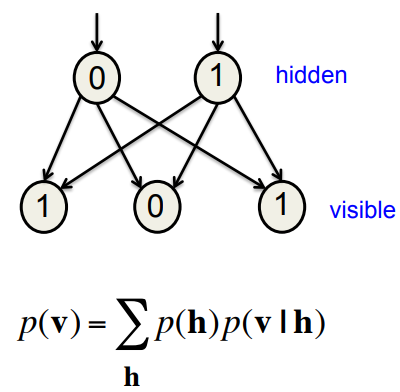
How a Boltzmann Machine generates data
- • It is not a causal generative model.
- • Instead, everything is defined in terms of the energies of joint configurations of the visible and hidden units.
- • The energies of joint configurations are related to their probabilities in two ways.
- – We can simply define the probability to be

- – Alternatively, we can define the probability to be the probability of finding the network in that joint configuration after we have updated all of the stochastic binary units many times.
- – We can simply define the probability to be
• These two definitions agree.
• 인과 관계 생성 모델이 아닙니다.
• 대신 모든 것은 visible units와 hidden units의 joint configurations 에너지로 정의됩니다.
• 연결 구성의 에너지는 두 가지 방법으로 확률과 관련됩니다.
- 우리는 단순히 확률을 정의 할 수 있습니다.
- 또는 확률적 이진 단위를 여러 번 업데이트 한 후에 해당 공동 구성에서 네트워크를 찾을 확률이 될 확률을 정의 할 수 있습니다.
•이 두 정의가 일치합니다.
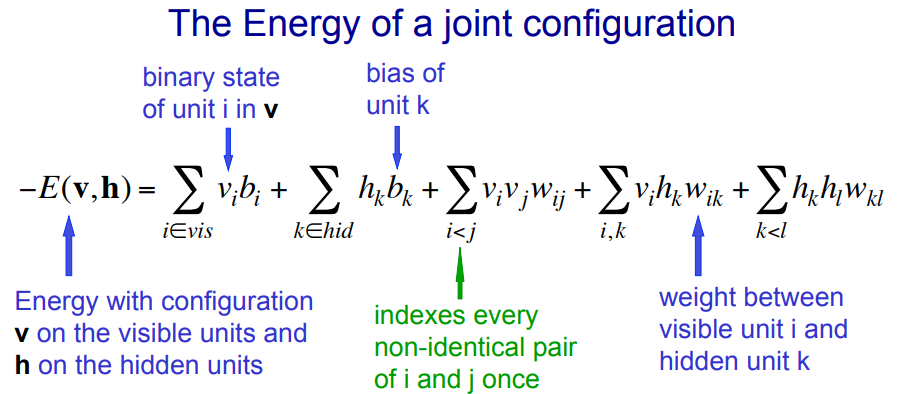
Using energies to define probabilities
- The probability of a joint configuration over both visible and hidden units depends on the energy of that joint configuration compared with the energy of all other joint configurations.
- visible units 과 hidden units 모두에 대한 The probability of a joint configuration 은 다른 모든 joint configuration 의 에너지와 비교한 joint configuration 의 에너지에 따라 달라집니다.
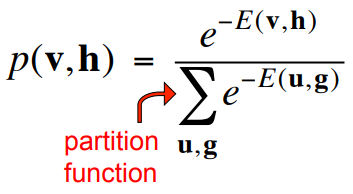
- The probability of a configuration of the visible units is the sum of the probabilities of all the joint configurations that contain it.
- The probability of a configuration of the visible units 은 그것을 포함하고 있는 모든 joint configurations 의 확률의 합입니다.
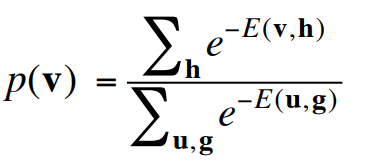
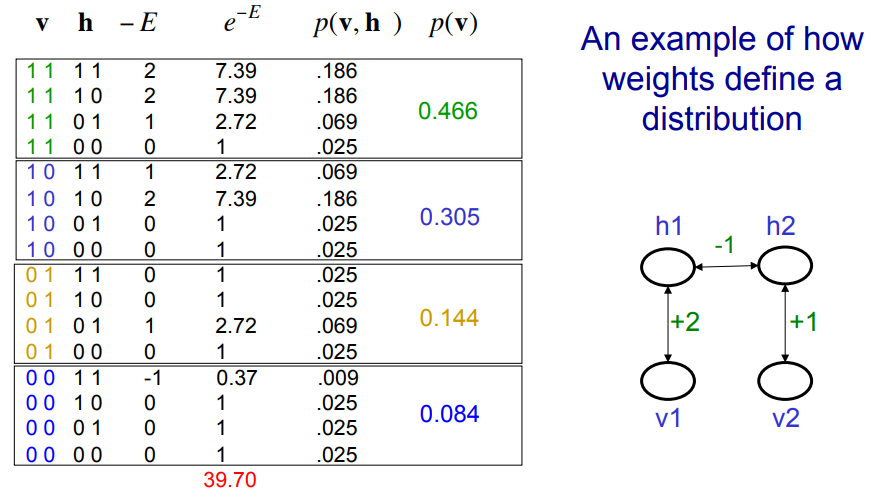 바이어스는 0으로 가정하고, 11a 강의 자료의 식 참조
바이어스는 0으로 가정하고, 11a 강의 자료의 식 참조
Getting a sample from the model
(모델에서 샘플 가져 오기)
- • If there are more than a few hidden units, we cannot compute the normalizing term (the partition function) because it has exponentially many terms.
- • So we use Markov Chain Monte Carlo to get samples from the model starting from a random global configuration:
- – Keep picking units at random and allowing them to stochastically update their states based on their energy gaps.
• Run the Markov chain until it reaches its stationary distribution (thermal equilibrium at a temperature of 1).
- – The probability of a global configuration is then related to its energy by the Boltzmann distribution.
• hidden units이 몇 개 이상일 경우 기하 급수적으로 많은 term 가 있기 때문에 정규화 term (파티션 함수)를 계산할 수 없습니다.
• Markov Chain Monte Carlo를 사용하여 임의의 전역 구성에서 시작하여 모델에서 샘플을 가져옵니다.
- 유닛을 무작위로 선택하고 에너지 갭을 기반으로 상태를 확률 적으로 업데이트 할 수있게하십시오.
• 마르코프 체인이 정상 분포 (온도 1에서의 열 평형)에 도달 할 때까지 실행하십시오.
- 글로벌 구성의 확률은 볼츠만 분포에 의해 에너지와 관련이있다.

Getting a sample from the posterior distribution over hidden configurations for a given data vector
(주어진 데이터 벡터에 대한 숨겨진 구성에 대한 사후 분포에서 샘플 얻기)
- • The number of possible hidden configurations is exponential so we need MCMC to sample from the posterior.
- – It is just the same as getting a sample from the model, except that we keep the visible units clamped to the given data vector.
- • Only the hidden units are allowed to change states
- – It is just the same as getting a sample from the model, except that we keep the visible units clamped to the given data vector.
• Samples from the posterior are required for learning the weights. Each hidden configuration is an “explanation” of an observed visible configuration. Better explanations have lower energy.
가능한 hidden configurations의 수는 기하급수적이므로 우리는 posterior로부터 샘플링하기 위해 MCMC가 필요합니다.
- visible units를 주어진 데이터 벡터에 고정시키는 것을 제외하고는 모델에서 샘플을 얻는 것과 같습니다.
- hidden units 만 상태를 변경할 수 있습니다
가중치를 배우기 위해서는 posterior의 샘플이 필요합니다. 각 hidden configuration은 관찰된 visible configuration의 "설명"입니다. 더 나은 설명은 에너지가 낮습니다.